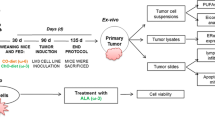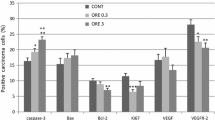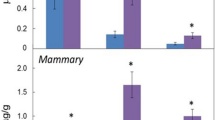Abstract
The monoterpene perillyl alcohol has been shown to induce the regression of 81% of small mammary carcinomas and up to 75% of advanced mammary carcinomas initiated by 7,12-dimethylbenz(a)anthracene (DMBA) in the Wistar-Furth rat. Dietary perillyl alcohol was greater than 5 times more potent than the monoterpene limonene at inducing tumor regression. Perilly alcohol is rapidly metabolized in the rat, as is limonene. Rats chronically fed perillyl alcohol had the same circulating plasma metabolites as rats fed limonene; however, the levels of these metabolites found in the plasma were higher for perillyl alcohol-fed rats. For example, rats given a 2% perillyl alcohol diet for 10 weeks had plasma levels of terpene metabolites of 0.82 mM whereas those fed a 10% limonene diet for the same period had blood levels of 0.27 mM. It thus appears that the increased potency of perillyl alcohol over limonene in causing tumor regression may be dee at least in part to differences in the pharmacokinetics of these two monoterpenes. We feel that perillyl alcohol is a good candidate for clinical testing of anticancer efficacy in humans.
Similar content being viewed by others
References
Crowell PL, Chang RR, Ren Z, Elson CE, Gould MN (1991) Selective inhibition of isoprenylation of 21–26 kDa proteins by the anticarcinogen d-limonene and its metabolites. J Biol Chem 266:17679
Crowell PL, Lin S, Vedejs E, Gould MN (1992) Identification of metabolites of the antitumor agent d-limonene capable of inhibiting protein isoprenylation and cell growth. Cancer Chemother Pharmacol 31:205
Crowell PL, Elson CE, Bailey HH, Elegbede JA, Haag JD, Gould MN (1994) Human metabolism of the experimental cancer therapeutic agent d-limonene. Cancer Chemother Pharmacol (in press)
Crowell PL, Ren Z, Lin S, Vedejs E, Gould MN (1994) Structure-activity relationships among novel monoterpene inhibitors of small G protein isoprenylation and cell proliferation. Biochem Pharmacol (in press)
Elegbede JA, Elson CE, Qureshi A, Tanner MA, Gould MN (1984) Inhibition of DMBA-induced mammary cancer by the monoterpene d-limonene. Carcinogenesis 5:661
Elegbede JA, Elson CE Tanner MA, Qureshi A, Gould MN (1986) Regression of rat primary mammary tumors following dietary d-limonene. J Natl Cancer Inst 76:323
Elson CE, Maltzman TH, Boston JL, Tanner MA, Gould MN (1988) Anticarcinogenic activity of d-limonene during the initiation and promotion/progression stages of DMBA-induced rat mammary carcinogenesis. Carcinogenesis 9:331
Freireich EJ, Gehan EA, Rall DP, Schmidt LH, Skipper HE (1966) Quantitative comparison of toxicity of anti-cancer agents in mouse, rat, dog, monkey and man. Cancer Chemother Rep 50:219
Haag JD, Lindstrom MJ, Gould MN (1991) Limonene-induced regression of mammary carcinomas. Cancer Res 52:4021
Igimi H, Nishimura M, Kodama R, Ide H (1974) Studies on the metabolism of d-limonene (p-mentha-1,8-diene). I. The absorption, distribution and excretion of d-limonene in rats. Xenobiotica 4:77
Jirtle RL, Haag JD, Ariazi EA, Gould MN (1993) Increased mannose 6-phosphate/insulin-like growth factor II receptor and TGF-β1 levels during monoterpene-induced regression of mammary tumors. Cancer Res 53:3849
Maltzman TH, Hurt LH, Elson CE, Tanner MA, Gould MN (1989) The prevention of nitrosomethylurea-induced mammary tumors by d-limonene and orange oil. Carcinogenesis 10:781
McClean SW, Ruddel ME, Gross EG, DeGiovanna JJ, Peck GL (1982) Liquid chromatographic assay for retinol (vitamin A) and retinol analogs in therapeutic trials. Clin Chem 28:693
McNamee D (1993) Limonene trial in cancer. Lancet 342:801
Ren Z, Gould MN (1994) Inhibition of ubiquinone and cholesterol synthesis by the monoterpene perillyl alcohol. Cancer Lett (in press)
Storer BE, Kim C (1990) Exact properties of some exact test statistics for comparing two binomial proportions. J Am Stat Assoc 85:146
Zwieten MJ van (1984) The rat as an animal model in breast cancer research. Martinus Nijhoff, Boston
Author information
Authors and Affiliations
Additional information
This work was supported by PHS NIH grant CA38128
Rights and permissions
About this article
Cite this article
Haag, J.D., Gould, M.N. Mammary carcinoma regression induced by perillyl alcohol, a hydroxylated analog of limonene. Cancer Chemother. Pharmacol. 34, 477–483 (1994). https://doi.org/10.1007/BF00685658
Received:
Accepted:
Issue Date:
DOI: https://doi.org/10.1007/BF00685658




